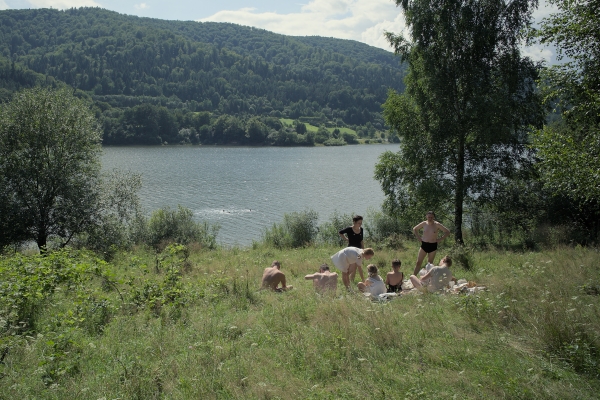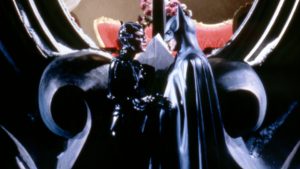
How dare the guardians of hell find solace on its perimeter? That is the question that Jonathan Glazer’s harrowing holocaust drama asks. Not so much about the banality of evil as the bureaucracy of evil, the stomach-churning film ruminates on the operational complexities of the Holocaust and the monstrous administrators who oversaw its execution, making for a new entry to the Holocaust recreation sub-genre that’s starkly unique and entirely haunting. Glazer and cinematographer Lukasz Zal capture the simple, beautiful domesticity of a Germany family living just outside the barbed-wire walls of Auschwitz, juxtaposing the visually appealing nature of their idyllic grounds against the soul-piercing aural nightmare sounding on the other side of the wall. That stark contrast and cognitive dissonance – trapping the audience between seeing beauty and hearing hell – creates a truly disturbing tension in The Zone of Interest, sure to make viewers queasy and entirely unsettled.
From the very first seconds of the film, Glazer cues the audience into the notion that sound should drive their engagement with the film. The Zone of Interest starts with minutes of darkness, our ears perking up to the sound of churning, industrial rhythm that’s eventually punctuated by chirping birds. We hear the contradiction before our eyes get the opportunity to complicate the scene further. Sound designer Johnnie Burn’s soundscape and unique deployment of sound is unlike anything else this viewer has seen/heard before. In an interview with the LA Times, Burns said, “Sound is 50% of the experience, and it has enormous power to turn the emotion or narrative.” The effect is truly startling, particularly in a series of (dare I say hopeful?) scenes shot in heat vision. In practice, Glazer has created a bifurcated experience; two films that play atop one another. One we see. The other we hear.
Glazer’s first feature film in a decade since 2013’s otherworldly study in isolation and humanity, Under the Skin, the writer-director’s ability to get under the viewer’s skin has only sharpened. We’re introduced to commandant Rudolf Höss (Christian Friedel), wife Hedwig (Sandra Hüller), and their four children, two sons, two daughters, as they enjoy a swim in a river by a meadow. If you didn’t know better, this blissful familial outing could be mistaken for a scene from a postcard-perfect memory. However, it is tainted by the foreknowledge of impending horrors and the lingering echo of banally horrific sounds that were played just moments earlier.
We spend the film with the Höss family as they navigate their ambitions and posture at living a normal family life. The fact that their accommodations are on the other side of Auschwitz’s fence, and that “Rudi” spends his days plotting the logistics of the accelerated extermination of thousands of Jews imported there each day, doesn’t seem to trouble them. This horror is never witnessed directly. Yet, the glow of burning chimneys shines a haunting radiance through their curtains at night, and loose artifacts of the Holocaust—bits of bone, teeth, clothes—constantly infringe upon their peace.
The Höss clan nurture a kind of mindful indifference to the screams, gunshots, crackle of fire, and chugga-chugga-choo-choo grind of hourly trains outside their window, inoculating themselves to the horror that they share a literal wall with. While Rudolf acknowledges that he is a cog in the greater bureaucratic wheels of the German Fatherland, he does not assign any moral condition to the work he carries out. He is a malevolent janitor, pure in his base ambition and rejection of human decency. Hedwig proves an arguably more sickening character. When Rudolf is reassigned, she refuses to leave Auschwitz, holding it to be some slice of heaven for her and her young children.
Glazer holds these characters to account in subtle ways, such as during a visit from Hedwig’s mother that quickly turns from maternal pride at her daughter’s elevated standing in the new Nazi hierarchy to a dawning awareness of the Holocaust’s exacting reality. Or when Rudolf visits a doctor to solve a stomach issue only to reveal there’s nothing physically out of sorts. It’s almost as if spending all day plotting the mechanics of mass murder may have a lingering impact. Moments like these suggest just how broken these administrators and bureaucrats of the Holocaust truly are. Their ability to overlook the psychological impact of such heinous crimes against humanity is abjectly disturbing, especially for a nation acting as refuge for Sigmund Freud.
One is left shattered by Glazer’s work, shaken by the meticulousness required for evil on that scale by the likes of the Höss family and so many others like them. Mica Levi’s score rips through the screen to penetrate the soul and inject every second with foreboding nightmare fuel, moments of it sounding as if burps have escaped hell itself. Taken together, the film is startlingly close to a masterpiece, amongst the very best – and certainly the most affecting – instances of cinema in 2023, though it’s hard to imagine an occasion where one would ever want to revisit this zone of interest.
CONCLUSION: Holocaust movies rarely inspire faith in humanity but Jonathan Glazer’s subtle examination of barren decency and bureaucratic evil is a startling reminder that mass scale horror requires meticulous detail and mindless execution. Shocking, horrifying, and essential.
A
Follow Silver Screen Riot on Facebook
Follow Silver Screen Riot on Twitter
The post Bureaucracy of Evil: ‘THE ZONE OF INTEREST’ appeared first on Silver Screen Riot.





